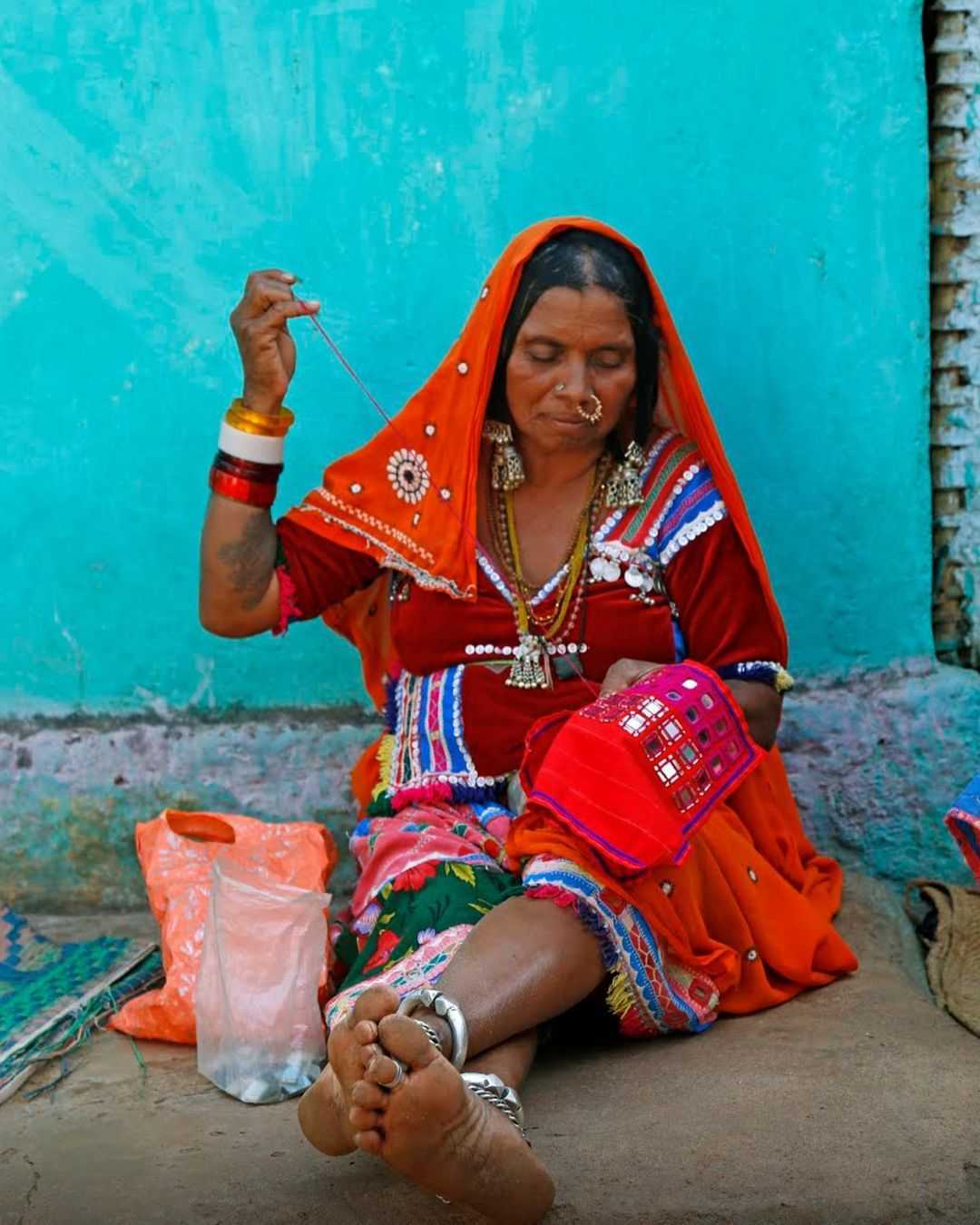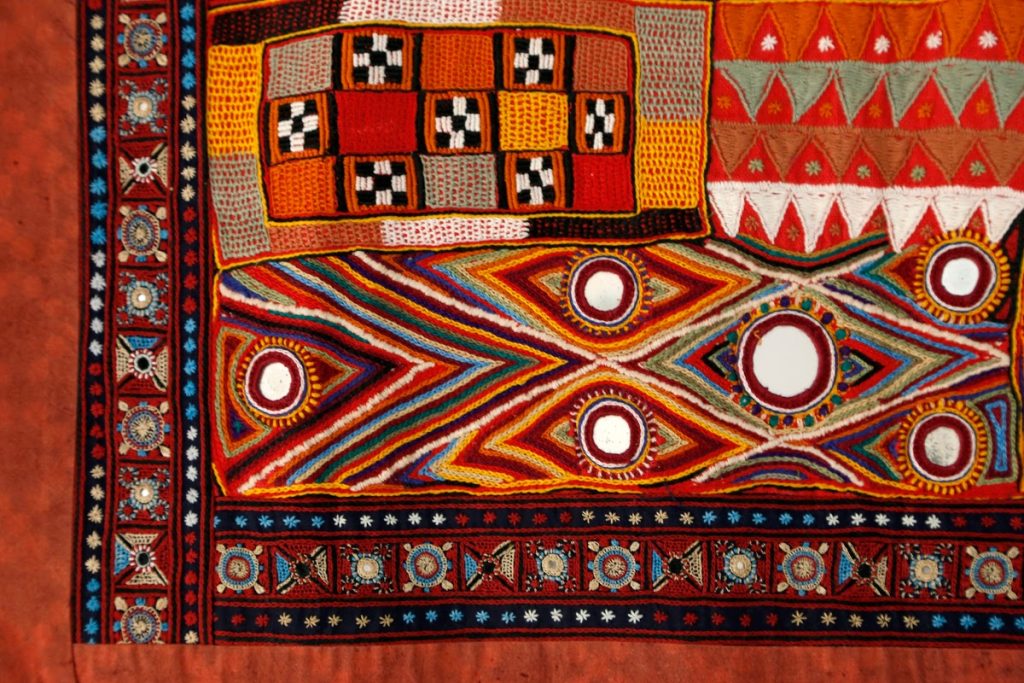In the heartland of Karnataka, lies an exquisite craft called Lambani embroidery. It is also known as Sandur Lambani embroidery, is an art form practised by the Lambani tribe, custodians of this enchanting tradition. With its roots tracing back to the 16th century when the Lambani tribe migrated from Rajasthan to Karnataka, this embroidery has captivated the world with its intricate stitches, vibrant colours, and rich symbolism. Embellished with mirrors, seashells, and a stunning array of stitches, Lambani embroidery breathes life into fabrics, creating a captivating symphony of artistry.
The lines and patterns adorning a sizable Lambani embroidery piece possess the remarkable ability to transform and shift at the whim of the embroiderer’s imagination, skill, and creative inspiration. Women have great agency over this craft, they utilise it to not only earn and be financially independent, but to express themselves creatively and showcase one of their many talents of manoeuvring threads and crafting something beautiful. The art of Lambani embroidery is a community practice wherein women traditionally sat together to make stunning embroidered pieces of textiles. Different materials such as threads, beads, coins, mirrors are beautifully encrusted within the coloured textile to further embellish it.
The women not only embroidery pieces that are worn on the body but everyday objects are often adorned with the embroidery, such as coverlets for the vessels carried to fetch water, home furnishings, etc. Items for utilitarian purposes are suddenly beautified and converted into pieces of great art simply through a few intricate stitches. Grandmothers pass on the meticulous skills to their grand-daughters and the art is simply just learnt and picked up by younger girls by observation and by being surrounded by women embroidering. There is something so simple yet captivating about a group of women engaging in works together and passing on traditions softly within generations of women. Speaking about this beautiful embroidery tradition in this article, we shall look into various aspects of Lambani embroidery
Types of stitches
Using around 30 different types of stitches and ten motif designs, Lambani craftswomen meticulously stitch colourful patches of cloth into exquisite works of art. The stitches, such as Valeya, Bakhiya, Ado Dora, Teen Sui Maaki, Suryakanti Maaki, and more, contribute to the stunning variety of textures and patterns found in Lambani embroidery.
Tradition and Belief
Lambani embroidery carries within it the echoes of ancient beliefs and traditions. Legend has it that Lambanis adorned themselves with garments adorned with mirrors to ward off wild animals in the jungles. This fascinating belief adds a touch of mystique to the art form, infusing it with a deep connection to nature and a sense of protection. As one admires the glistening mirrors reflecting light and life, the cultural tapestry of the Lambani tribe comes alive.
The Craftsmanship Behind Lambani Embroidery
The creation of Lambani embroidery is a labour of love, skillfuly blending age-old techniques with contemporary aesthetics. The process begins with the acquisition of suitable cotton cloth or khadi from Erode in Tamil Nadu, ensuring a harmonious relationship with local small-scale industries. The cloth is then dyed using both chemical and organic colours, reflecting the tribe’s adaptability to changing times while preserving their traditional roots.
Once the fabric is dyed, it is meticulously cut and ironed to achieve a smooth texture. Craftswomen then stitch the fabric patches together according to the design, carefully marking the placements for mirrors, seashells, and further embroidery. These exquisite embellishments are meticulously sewn using 14 different stitching techniques, resulting in a vibrant range of accessories. With a palette of thirteen colours at their disposal, the craftswomen bring life to their creations, with red and blue being the most commonly used hues.

Recognition and Global Reach
The exceptional craftsmanship and cultural significance of Lambani embroidery have not gone unnoticed. In 2010, it was awarded the prestigious Geographical Indication (GI) tag, acknowledging its uniqueness and the intricate process behind its creation. This recognition has empowered approximately 300 Lambani craftswomen in and around Sandur to benefit from the GI registration, providing them with a distinct identity and enabling them to showcase their art on a global platform.
Lambani embroidery has gained worldwide acclaim. Its exquisite bed sheets and cushion covers, adorned with subtle colors, are sought after by connoisseurs of art and textile enthusiasts. However, it is the heavily embroidered bags, bursting with vibrant colours, that continue to captivate tourists with their irresistible charm.

Preserving Tradition and Embracing Sustainability
While chemical dyes have been traditionally used in Lambani embroidery, there is a growing trend towards incorporating natural vegetable dyes. Derived from sources like Kattha, Rathanjot, Chawal Kudi, and Pomegranate peel, these organic dyes not only add to the beauty of the craft but also contribute to sustainable practices. The harmonious relationship between Lambani embroidery and the local small-scale industry fosters a sense of community, promoting economic growth and preserving traditional skills.Today, with changing times, the crafts made with Lambani embroidery are varied to meet the demands of the contemporary markets. Some of the vast range of items that these women now embroider are – bed linens, pouches, bags, cushion covers, wall-hangings, dupattas, etc. Their work is still loved and admired by those who love rich colourful tapestry, and the “bohemian” look.

Lambani embroidery signifies the spirit of the Lambani tribe, the custodians of this extraordinary art form. From its humble beginnings as a means to protect against wild animals, it has blossomed into a globally renowned craft, capturing the imagination of art lovers worldwide. With its vivid colors, intricate stitches, and timeless motifs, Lambani embroidery reflects the beauty of Karnataka’s cultural heritage. As craftswomen meticulously stitch together vibrant patches of fabric, they create not just breathtaking art but also a bridge that connects us to the rich tapestry of human creativity and tradition. Let us celebrate Lambani embroidery for its enduring beauty, its cultural significance, and the captivating stories it tells through each meticulously crafted stitch.

Contributor





